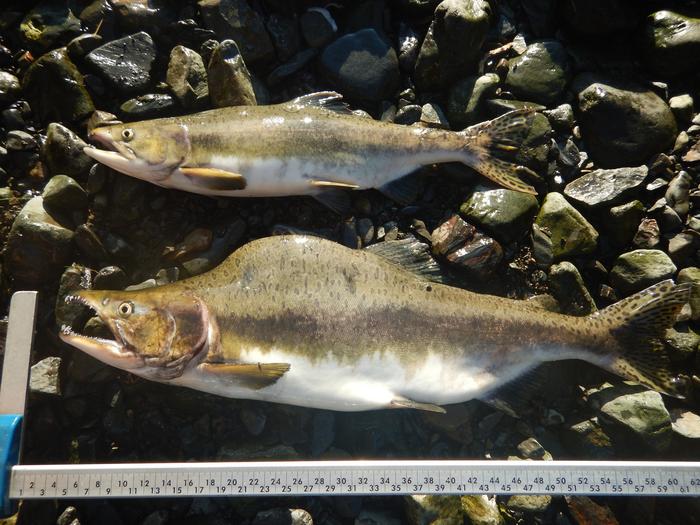The ability of salmon hatcheries to increase wild salmon abundance may come at the cost of reduced diversity among wild salmon, according to a new University of Alaska Fairbanks–led study.

Credit: Photo by Julia McMahon
The ability of salmon hatcheries to increase wild salmon abundance may come at the cost of reduced diversity among wild salmon, according to a new University of Alaska Fairbanks–led study.
The number of juvenile salmon released into the North Pacific Ocean by hatcheries increased rapidly in the second half of the last century and remains at over 5 billion each year. Salmon hatcheries have helped push annual pink salmon harvests in Prince William Sound from about 4 million fish prior to hatchery programs to roughly 50 million in recent years.
Using data collected from pink salmon streams in Prince William Sound, Alaska, through the Alaska Hatchery Research Project, researchers determined that many hatchery-raised fish are straying onto natural spawning grounds and interbreeding with wild populations. In a related study, researchers used simulations developed with the real-world data to ask what this continued input of hatchery fish might mean for wild populations.
“Even if only a small percentage of hatchery-origin fish stray into wild populations, a small fraction of a huge number can still be a lot,” said Samuel May, lead author of the newly published study in the journal Royal Society Open Science. “We were interested in exploring the long-term consequences of hatchery straying for wild population recruitment and resilience.”
Life-history diversity is a distinguishing characteristic of wild salmon, which are specifically adapted to the local conditions of their home streams. Simulations showed that wild fish population sizes increased because more fish reproduced than would have without hatchery strays. Those increases came at a cost: As hatchery-origin gene variants spread into wild populations, diversity among those populations was reduced.
“Wild populations can be very different from one another, but hatchery fish are often more alike. If many individuals with relatively similar traits are introduced into diverse populations, it can make those populations more alike. Lower diversity among populations can reduce resilience to future changes” said May, who conducted the study as a postdoctoral fellow at UAF’s College of Fisheries and Ocean Sciences.
Previous studies have shown that hatchery-origin salmon, which may be adapted to environments different from those they stray into and which don’t face the same evolutionary pressures as fish born in natural streams, produce about half as many offspring as wild fish. Introducing those gene variants into wild salmon populations could potentially affect their ability to adapt to future challenges in nature.
The simulations tapped into an ongoing project in Prince William Sound that has gathered tissue samples from hundreds of thousands of pink salmon since 2011. The Alaska Hatchery Research Program has collected samples from 30 streams in the region, providing a huge collection of DNA and other data for conducting research to inform Alaska policies and sustainable resource management. This unprecedented sampling effort allows researchers to recreate the family trees of pink salmon from five of these sampled streams in the region and determine which fish can be traced back to hatcheries.
May cautioned that, as with any simulation, it can be difficult to fully capture all the complex relationships in nature. Modeling for the study was specific to pink salmon in Prince William Sound, he said, and overarching conclusions about other systems or species should be done with care.
“The same things that make these kinds of models incredibly useful in specific contexts — like their simplifying assumptions and being parameterized with empirical data — also make them misleading if applied in the wrong context,” May said.
Other contributors to the paper included authors from the Alaska Department of Fish and Game and the National Oceanic and Atmospheric Administration. The Alaska Hatchery Research Project is a collaborative endeavor between the Alaska Department of Fish and Game, hatchery operators, nongovernmental organizations and academics.
“Salmon hatcheries in Alaska have become a flash point, making discussions of policy options mired in contention and acrimony,” said Peter Westley, a UAF associate professor of fisheries and principal investigator for the project. “Hopefully this work can guide conversations by serving as an agreed upon reality — hatcheries can increase salmon abundance of both hatchery and wild individuals, but it comes with an inherent trade-off for wild fish ecological diversity such as run timing.”
Journal
Royal Society Open Science
Method of Research
Data/statistical analysis
Subject of Research
Animals
Article Title
Salmon hatchery strays can demographically boost wild populations at the cost of diversity: quantitative genetic modelling of Alaska pink salmon
Article Publication Date
3-Jul-2024



